If you’re a coffee lover, you’ve got to try Ethiopian coffee. With so many options, where should you start? In this guide, you’ll learn about the best beans, regions, and methods for coffee from Ethiopia.
Ethiopia is the birthplace of coffee and has some of the most dynamic flavors you’ll find anywhere in the world. There are between 6 and 10 thousand different types of coffee from Ethiopia, but they are usually distinguished by their region, altitude, and cupping score instead of by type.
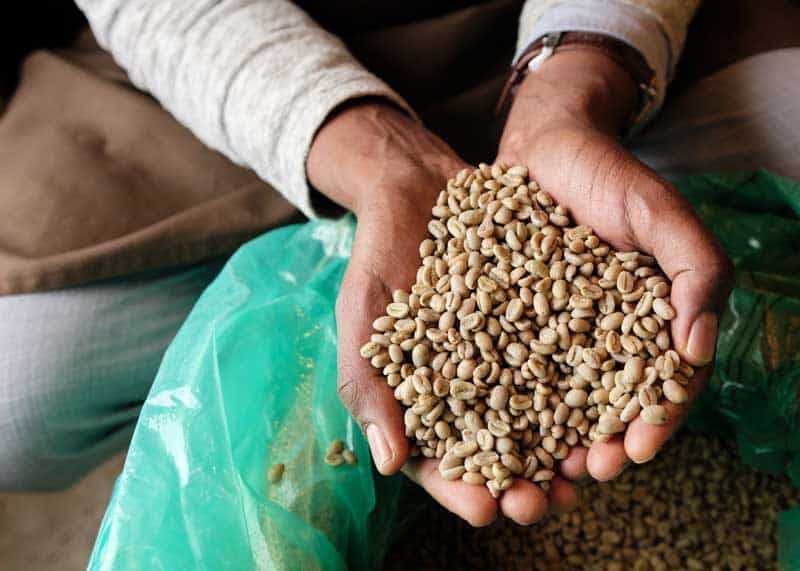
In this guide, to Ethiopian coffee, you’ll learn about its history, flavors, regions, and how to make it. Get ready to go all the way back to the origin of that dark drink we all know and love!
With a little background, you’ll be ready to try some today.
Table of Contents
The History of Ethiopian Coffee
A fascinating mixture of history and legend lies behind the discovery of coffee in Ethiopia. No one really knows quite where the legend ends and the history begins, however, most experts agree that Ethiopia is the only place in the world where coffee grows natively.
According to legend, a goat herder by the name Kaldi discovered that his goats were eating cherries that wound them up with endless energy. He decided to bring some of the cherries to local monks who might be able to tell him why they made his goats so much more active.
Upon seeing the cherries the monks threw them into a fire, fearing they may contain some evil magic. When they began to burn, however, the aroma they gave off was so enticing that the monks decided to remove them from the fire, ground them up and place them in a container of water. Later, the monks tried the first-ever brew, and voila, the art of drinking coffee was born.
Most historians only take the tale of Kaldi to be apocryphal and believe it is more likely that coffee was discovered by the nomadic Oromo people.
Since its discovery, it has slowly become the biggest export from Ethiopia and has remained that way through major government changes and social upheaval. To this day 60% of exports from Ethiopia are in coffee.
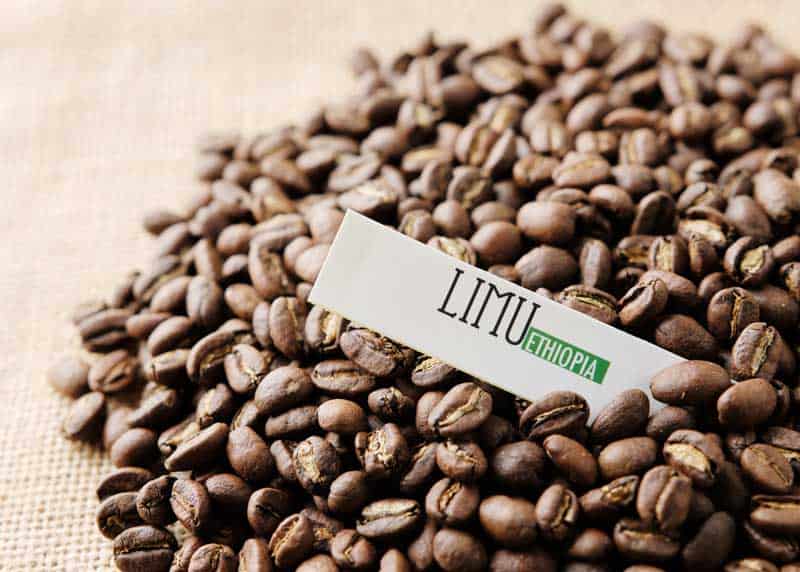
Where Did Coffee Originate?
Did coffee originate in Ethiopia? Yes, the coffee plant originated from Kaffa, a region in southwestern Ethiopia.
The Kafa Biosphere Reserve is located in the Kafa Zone of Ethiopia. It is inside this area where coffee was first discovered. And according to UNESCO, it is currently home to almost 5,000 wild Arabica coffee varieties.
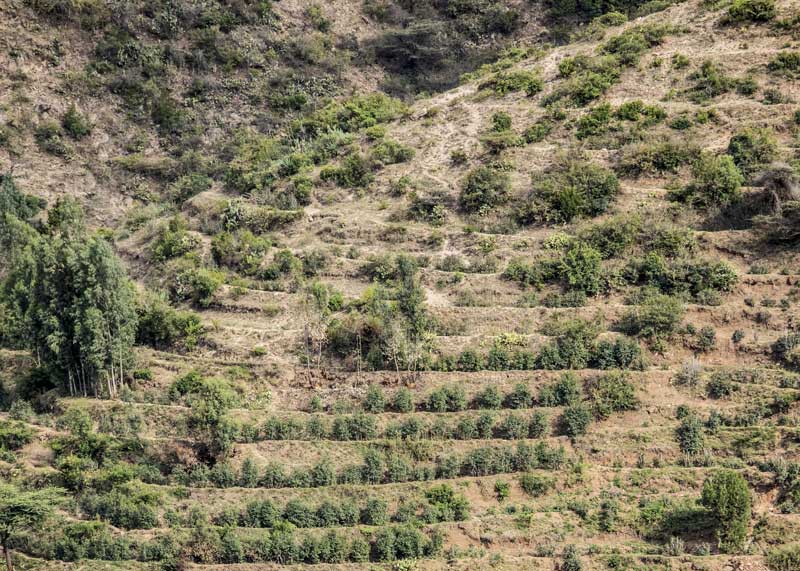
Ethiopian Coffee Trademarks and Branding
To brand and protect the uniqueness of the product, Ethiopian coffee growers, importers, and even the Ethiopian national government have created networks, branding programs, and trademarks.
The most famous legal battle was Starbucks vs Ethiopia. This involved the licensing of these three Ethiopian coffee brands: Harar, Sidamo, and Yirgacheffe.
Ethiopian Geography & Coffee Growth
The coffee plants that grow indigenously are known as heirloom varieties due to their rich history of growing in a near-perfect natural environment, that seems almost built to grow coffee.
The soil where they primarily grow is just acidic enough for the plants to thrive.
Coupled with the high altitudes in mountainous regions and just the right amounts of rain make Ethiopia the perfect place for coffee to thrive.
9 Ethiopian Coffee Grading Categories
Ethiopian coffee beans are graded 1 through 9 by visual inspection for any defects and cup quality.
- 1-2: Specialty grade
- 3-9: Commercial grade
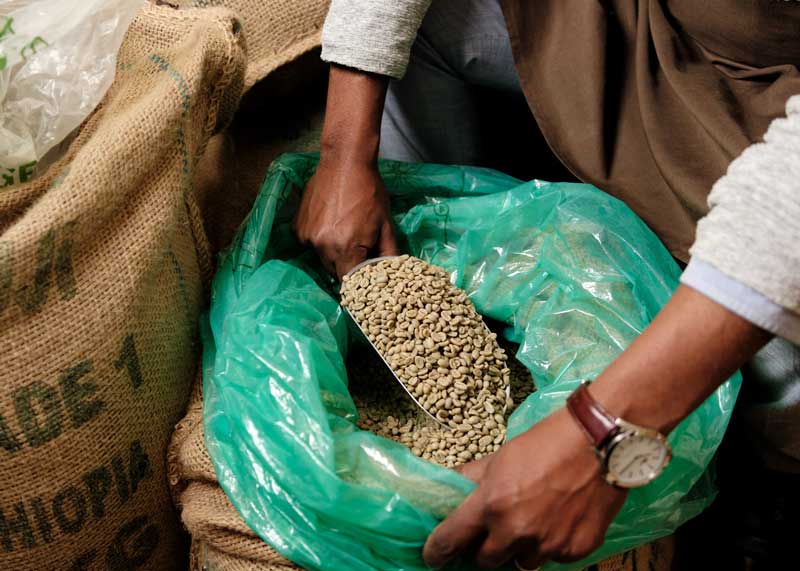
6 Ethiopian Coffee Regions
There are six major coffee regions in Ethiopia, though it is important to note that there are also sub-regions that go by their own name simply because they are trademarked.
Below we’ll outline the six major regions and point out the trademarks included in them.
1. Sidamo
Sidamo: This is the region where it is believed coffee originated. It is grown in the highlands between 4,920 and 7,220 feet above sea level. This means that the beans are considered “strictly high grown” (SHG) and have more time to gather nutrients from the soil which can result in a distinct flavor profile.
Sidamo’s coffee beans contain notes of citrus, berries, and lemon giving them a more acidic taste while maintaining a medium body. Please note that Sidamo includes Yirgacheffe and Guji coffee as well if you ever see those marketed as regions themselves.
Read more about how to describe coffee flavor notes.
2. Yirgacheffe
While it is included above, Yirgacheffe is too important not to include in this list. Yirgacheffe coffee is considered to be among the best coffee in the world. It is grown at roughly 2,000 meters and is wet-processed.
Read more about Yirgacheffe coffee.
3. Guji
Guji: Guji zone coffee comes from southeastern Ethiopia. Heirloom varieties produce a full-flavored, strong coffee. The Guji coffee zone was created in 2002 and named after a Oromia tribe.
Coffee from the Guji zone presents a distinctive terroir that sets it apart from the larger Oromia region. Flavor notes include dark chocolate, floral, and sweetly tart acidity.
4. Harar
Harar: Harar is another one of the oldest coffee beans that continue to be produced to this day. It is cultivated in Ethiopia’s Eastern highlands and is still sorted and processed by hand.
It is generally thought to have hints of fruit, wine, and mocha in its flavor profile. Unlike Sidamo, it isn’t known for being extremely acidic but rather more balanced and full-bodied.
5. Genika
Genika: These are exclusively grown in the Bench Maji Zone of Ethiopia. They are therefore referred to as beans of a “single origin.” These small greyish coffee beans are known for a chocolate taste with hints of spice and wine and an especially appealing aroma.
6. Limu
Limu: Limu coffee beans are wet-processed and known for low acidity. Limu coffee comes from Limmu Sakka district (woredas) in the Oomia Region of Ethiopia. It is located west of Addis Ababa.
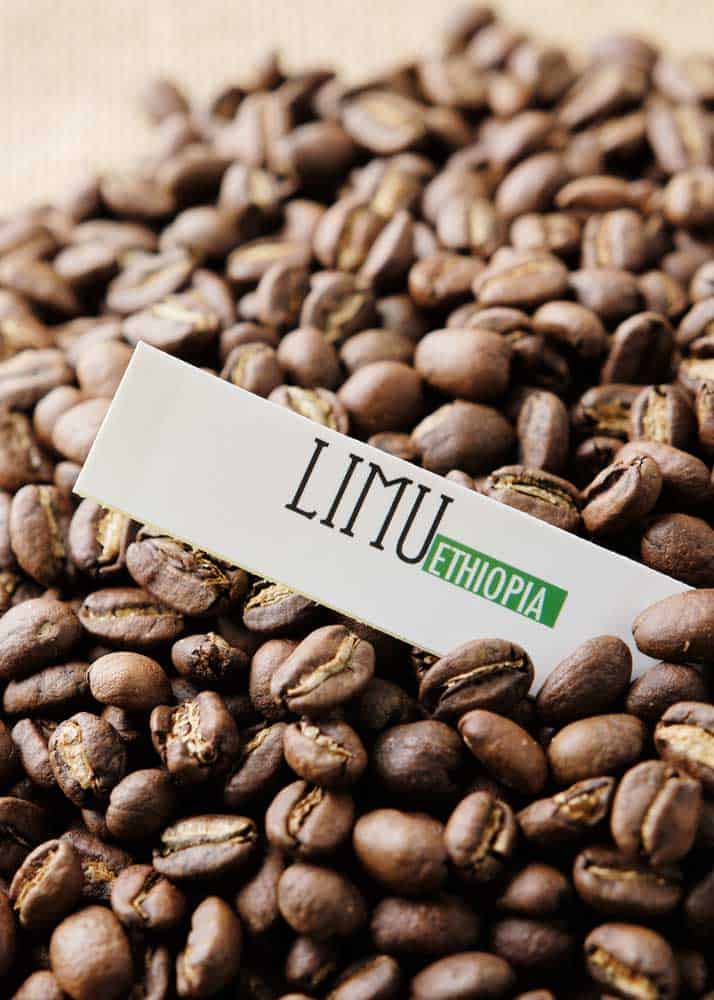
Ethiopian Coffee Beans: 3 Categories
There are three categories of Ethiopian coffee beans from the species Coffea arabica:
- Longberry: The largest of the three and the highest in quality.
- Shortberry: Smaller than longberry but still considered high quality.
- Mocha: Small but filled with a complex flavor profile that includes some acidity, spice, and even chocolate flavors.
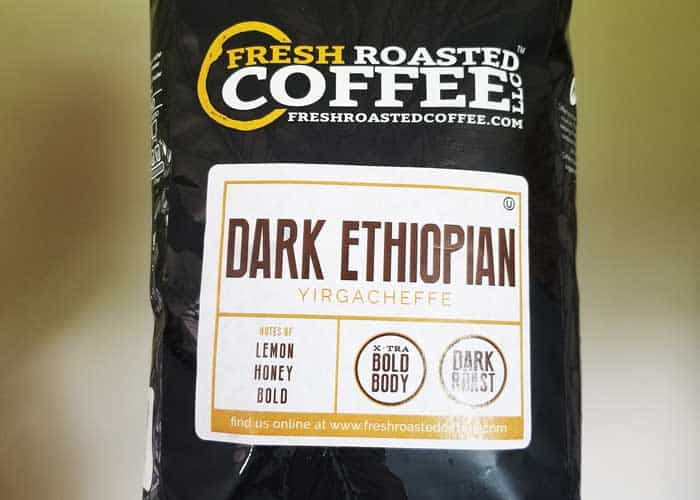
How Ethiopian Coffee Beans Are Processed
Ethiopian coffee beans are processed either by sun-drying them or washing them.
Here’s how it’s done:
- Sun-drying: The cherries are first sorted by hand so that only the denser and higher-quality ones move on to the next step.
They are then placed on raised drying beds made of wood posts that are covered in burlap or nylon netting and set out in the sun for weeks to dry. Finally, they are milled to remove the husks and packaged for sale. - Wet Processing: The cherries are placed in water for sorting, as the less dense cherries will float and the denser ones will sink. They use eco-pulpers to remove the skin to get to the parchment coffee.
Next, they remove mucilage by keeping the parchment coffee in a fermentation tank for two or three days. Once that is finished the coffee is placed in a soaking tank for twelve hours then put on a raised bed to dry for around two weeks.
They sort through the dried coffee to find any beans that have been damaged and send the good ones to a warehouse for dry processing. Finally, it is packaged and ready to sell.
Processing coffee berries is very labor-intensive. The berries and beans are handled numerous times before making it to market.
In this video, you’ll see the difference between wet and dry coffee processing in Ethiopia.
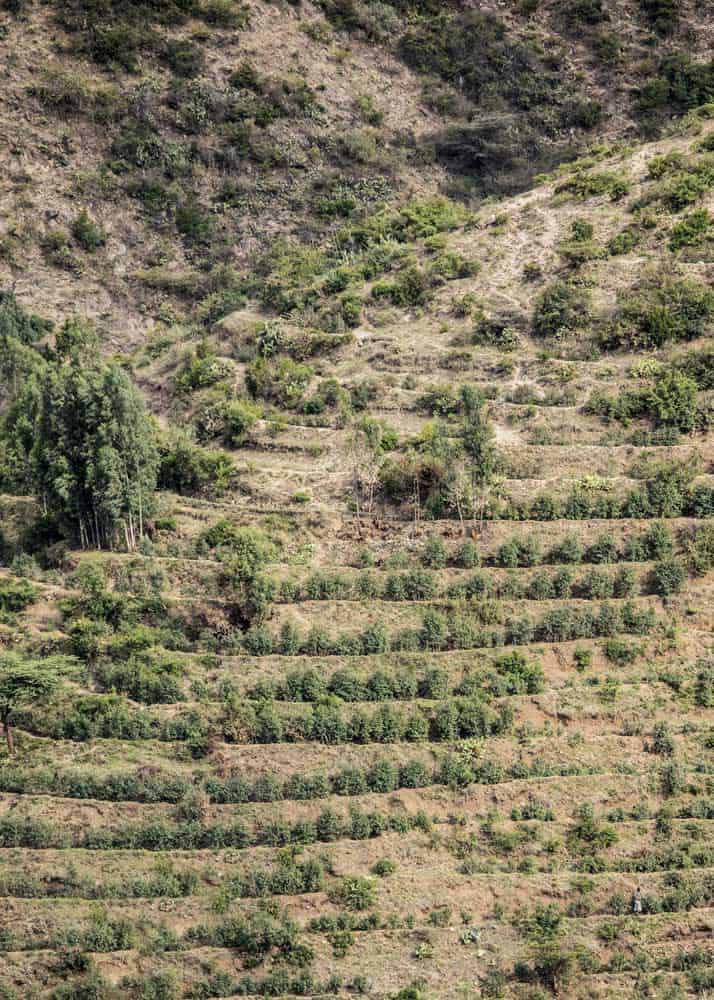
What Does Ethiopian Coffee Taste Like?
Ethiopian coffee is notorious for having a flowery taste with hints of wine as well as a slight berry aftertaste.
Depending on the region, they are medium to high in acidity, light to medium in body, and varied in their flavor notes.
The reason why they have so many fruity, wine-like and flowery flavors, is mainly due to the fact the beans are often dried while still contained within the cherry fruit of the coffee plant.
Here’s what a small coffee shop in Addis Ababa looks like. And how coffee is served in a jebena over hot charcoal. Notice how the coffee is ground by hand.
Best Ethiopian Coffee Available Today
While the best Ethiopian coffee available today is subjective to a large extent, coffee brands from the Yirgacheffe region (this is included in Sidamo), almost always find their way onto lists of people’s favorites.
This Yirgacheffe coffee by Volcanica is very popular.
People tend to like Yirgacheffe coffee because of the way they are organically grown and cultivated by hand. They have a medium body, high acidity, and are packed with the notorious fruity and wine-like flavors of Ethiopian coffee.
Their aroma as well has been described as “cinnamon with strawberry undertones.”
If you want to get a good idea of what makes Ethiopian coffee so delicious, Yirgacheffe is a great starting point!
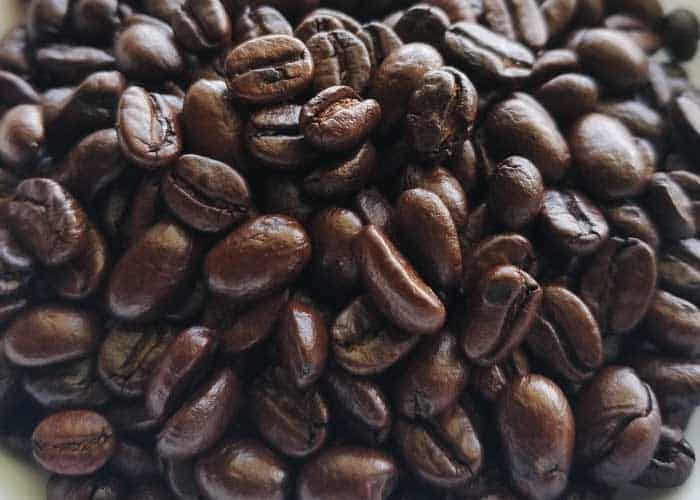
Coffee Experts Discuss Ethiopian Coffee
In this video by Invest Ethiopia, a set of coffee experts share what they love about coffee from Ethiopia.
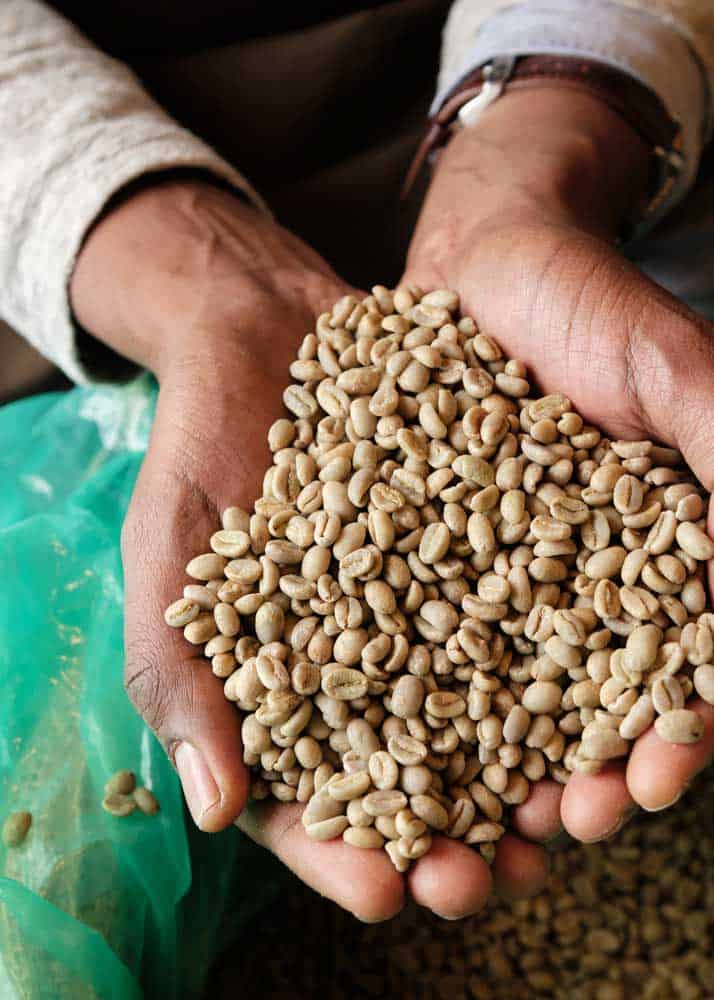
More reading: How to Make Coffee (17 Best Brewing Methods)
Which Ethiopian Coffee Will You Try?
You should try Ethiopian coffee if for no other reason than because it is the only place coffee has its origins and grows naturally. On top of that, you’ll get to enjoy fruity, wine-like flavors over a medium body that is irresistible.
In today’s world, there’s no excuse for not at least trying Ethiopian coffee if you’re a coffee lover.
You don’t have to go halfway around the world to get some yourself. All of the regional coffees we have discussed are readily available on Amazon! The only question left is which will you try?
- About the Author
- Latest Posts
Dena Haines is a co-founder and blogger on EnjoyJava – and is working to make it the best coffee blog in the world.
She also blogs about travel at Storyteller.Travel and photography at Storyteller Tech. Dena is a partner at Storyteller Media, a publishing company she started with her husband, Bryan.


Chala
Sunday 14th of January 2024
Most historians only take the tale of Kaldi to be apocryphal and believe it is more likely that coffee was discovered by the nomadic Galla tribe. Remove this word no tribe called Galla' in Ethiopia.
Bryan Haines
Tuesday 30th of January 2024
Thanks for the clarification. I've corrected the post to attribute the discovery of coffee to the Oromo people.
Temesgen
Friday 16th of December 2022
I want to learn more from your organization, we are new company coming to coffee export business in Ethiopia, Amaro District
Nayo
Monday 17th of October 2022
Very nice article. I wish you could have taken pictures of all the different types of coffee beans than only two so that your readers would see the different types of beans.
Binyam
Monday 25th of April 2022
I learnt a lot from this facts about Ethiopian coffee, but still it is to difficult understand value chain in coffee Market?